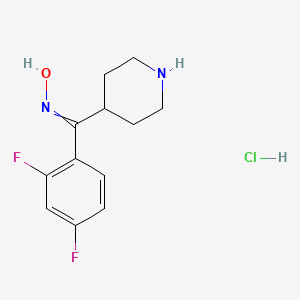Patent
US07307168B2
Procedure details


To a solution of 36.0 g (0.16 mole) of 3-(2-chloroethyl)-6,7,8,9-tetrahydro-2-methyl-4H-pyrido[1,2-a]pyrimidin-4-one in 800 ml of acetonitrile 44.3 g of 4-(2,4-difluoro-benzoyl)-piperidine-oxime-hydrochloride, 33.6 g of sodium hydrogen carbonate and 0.66 g (4 millimoles) of potassium iodide are added. The reaction mixture is refluxed for 5 hours, cooled to room temperature and the solvent is removed in vacuo. The residue is taken up in 700 ml of water and extracted twice with 600 ml of dichloromethane each. The combined organic layers are dried over sodium sulfate and evaporated in vacuo. Thus 63.7 g of the title compound are obtained. Yield 92.5%. M.p.: 180-183° C.
Quantity
36 g
Type
reactant
Reaction Step One

Quantity
0 (± 1) mol
Type
reactant
Reaction Step One




Name
Yield
92.5%
Identifiers


|
REACTION_CXSMILES
|
Cl[CH2:2][CH2:3][C:4]1[C:9](=[O:10])[N:8]2[CH2:11][CH2:12][CH2:13][CH2:14][C:7]2=[N:6][C:5]=1[CH3:15].Cl.[F:17][C:18]1[CH:32]=[C:31]([F:33])[CH:30]=[CH:29][C:19]=1[C:20](=[N:27][OH:28])[CH:21]1[CH2:26][CH2:25][NH:24][CH2:23][CH2:22]1.C(=O)([O-])O.[Na+]>C(#N)C.[I-].[K+]>[F:17][C:18]1[CH:32]=[C:31]([F:33])[CH:30]=[CH:29][C:19]=1[C:20](=[N:27][OH:28])[CH:21]1[CH2:26][CH2:25][N:24]([CH2:2][CH2:3][C:4]2[C:9](=[O:10])[N:8]3[CH2:11][CH2:12][CH2:13][CH2:14][C:7]3=[N:6][C:5]=2[CH3:15])[CH2:23][CH2:22]1 |f:1.2,3.4,6.7|
|
Inputs


Step One
|
Name
|
|
|
Quantity
|
36 g
|
|
Type
|
reactant
|
|
Smiles
|
ClCCC1=C(N=C2N(C1=O)CCCC2)C
|
|
Name
|
|
|
Quantity
|
0 (± 1) mol
|
|
Type
|
reactant
|
|
Smiles
|
Cl.FC1=C(C(C2CCNCC2)=NO)C=CC(=C1)F
|
|
Name
|
|
|
Quantity
|
33.6 g
|
|
Type
|
reactant
|
|
Smiles
|
C(O)([O-])=O.[Na+]
|
|
Name
|
|
|
Quantity
|
800 mL
|
|
Type
|
solvent
|
|
Smiles
|
C(C)#N
|
|
Name
|
|
|
Quantity
|
0.66 g
|
|
Type
|
catalyst
|
|
Smiles
|
[I-].[K+]
|
Conditions


Temperature
|
Control Type
|
AMBIENT
|
Other
|
Conditions are dynamic
|
1
|
|
Details
|
See reaction.notes.procedure_details.
|
Workups


TEMPERATURE
|
Type
|
TEMPERATURE
|
|
Details
|
The reaction mixture is refluxed for 5 hours
|
|
Duration
|
5 h
|
CUSTOM
|
Type
|
CUSTOM
|
|
Details
|
the solvent is removed in vacuo
|
EXTRACTION
|
Type
|
EXTRACTION
|
|
Details
|
extracted twice with 600 ml of dichloromethane each
|
DRY_WITH_MATERIAL
|
Type
|
DRY_WITH_MATERIAL
|
|
Details
|
The combined organic layers are dried over sodium sulfate
|
CUSTOM
|
Type
|
CUSTOM
|
|
Details
|
evaporated in vacuo
|
Outcomes


Product
|
Name
|
|
|
Type
|
product
|
|
Smiles
|
FC1=C(C=CC(=C1)F)C(C1CCN(CC1)CCC1=C(N=C2N(C1=O)CCCC2)C)=NO
|
Measurements
| Type | Value | Analysis |
|---|---|---|
| AMOUNT: MASS | 63.7 g | |
| YIELD: PERCENTYIELD | 92.5% |
Source


|
Source
|
Open Reaction Database (ORD) |
|
Description
|
The Open Reaction Database (ORD) is an open-access schema and infrastructure for structuring and sharing organic reaction data, including a centralized data repository. The ORD schema supports conventional and emerging technologies, from benchtop reactions to automated high-throughput experiments and flow chemistry. Our vision is that a consistent data representation and infrastructure to support data sharing will enable downstream applications that will greatly improve the state of the art with respect to computer-aided synthesis planning, reaction prediction, and other predictive chemistry tasks. |
Patent
US07307168B2
Procedure details


To a solution of 36.0 g (0.16 mole) of 3-(2-chloroethyl)-6,7,8,9-tetrahydro-2-methyl-4H-pyrido[1,2-a]pyrimidin-4-one in 800 ml of acetonitrile 44.3 g of 4-(2,4-difluoro-benzoyl)-piperidine-oxime-hydrochloride, 33.6 g of sodium hydrogen carbonate and 0.66 g (4 millimoles) of potassium iodide are added. The reaction mixture is refluxed for 5 hours, cooled to room temperature and the solvent is removed in vacuo. The residue is taken up in 700 ml of water and extracted twice with 600 ml of dichloromethane each. The combined organic layers are dried over sodium sulfate and evaporated in vacuo. Thus 63.7 g of the title compound are obtained. Yield 92.5%. M.p.: 180-183° C.
Quantity
36 g
Type
reactant
Reaction Step One

Quantity
0 (± 1) mol
Type
reactant
Reaction Step One




Name
Yield
92.5%
Identifiers


|
REACTION_CXSMILES
|
Cl[CH2:2][CH2:3][C:4]1[C:9](=[O:10])[N:8]2[CH2:11][CH2:12][CH2:13][CH2:14][C:7]2=[N:6][C:5]=1[CH3:15].Cl.[F:17][C:18]1[CH:32]=[C:31]([F:33])[CH:30]=[CH:29][C:19]=1[C:20](=[N:27][OH:28])[CH:21]1[CH2:26][CH2:25][NH:24][CH2:23][CH2:22]1.C(=O)([O-])O.[Na+]>C(#N)C.[I-].[K+]>[F:17][C:18]1[CH:32]=[C:31]([F:33])[CH:30]=[CH:29][C:19]=1[C:20](=[N:27][OH:28])[CH:21]1[CH2:26][CH2:25][N:24]([CH2:2][CH2:3][C:4]2[C:9](=[O:10])[N:8]3[CH2:11][CH2:12][CH2:13][CH2:14][C:7]3=[N:6][C:5]=2[CH3:15])[CH2:23][CH2:22]1 |f:1.2,3.4,6.7|
|
Inputs


Step One
|
Name
|
|
|
Quantity
|
36 g
|
|
Type
|
reactant
|
|
Smiles
|
ClCCC1=C(N=C2N(C1=O)CCCC2)C
|
|
Name
|
|
|
Quantity
|
0 (± 1) mol
|
|
Type
|
reactant
|
|
Smiles
|
Cl.FC1=C(C(C2CCNCC2)=NO)C=CC(=C1)F
|
|
Name
|
|
|
Quantity
|
33.6 g
|
|
Type
|
reactant
|
|
Smiles
|
C(O)([O-])=O.[Na+]
|
|
Name
|
|
|
Quantity
|
800 mL
|
|
Type
|
solvent
|
|
Smiles
|
C(C)#N
|
|
Name
|
|
|
Quantity
|
0.66 g
|
|
Type
|
catalyst
|
|
Smiles
|
[I-].[K+]
|
Conditions


Temperature
|
Control Type
|
AMBIENT
|
Other
|
Conditions are dynamic
|
1
|
|
Details
|
See reaction.notes.procedure_details.
|
Workups


TEMPERATURE
|
Type
|
TEMPERATURE
|
|
Details
|
The reaction mixture is refluxed for 5 hours
|
|
Duration
|
5 h
|
CUSTOM
|
Type
|
CUSTOM
|
|
Details
|
the solvent is removed in vacuo
|
EXTRACTION
|
Type
|
EXTRACTION
|
|
Details
|
extracted twice with 600 ml of dichloromethane each
|
DRY_WITH_MATERIAL
|
Type
|
DRY_WITH_MATERIAL
|
|
Details
|
The combined organic layers are dried over sodium sulfate
|
CUSTOM
|
Type
|
CUSTOM
|
|
Details
|
evaporated in vacuo
|
Outcomes


Product
|
Name
|
|
|
Type
|
product
|
|
Smiles
|
FC1=C(C=CC(=C1)F)C(C1CCN(CC1)CCC1=C(N=C2N(C1=O)CCCC2)C)=NO
|
Measurements
| Type | Value | Analysis |
|---|---|---|
| AMOUNT: MASS | 63.7 g | |
| YIELD: PERCENTYIELD | 92.5% |
Source


|
Source
|
Open Reaction Database (ORD) |
|
Description
|
The Open Reaction Database (ORD) is an open-access schema and infrastructure for structuring and sharing organic reaction data, including a centralized data repository. The ORD schema supports conventional and emerging technologies, from benchtop reactions to automated high-throughput experiments and flow chemistry. Our vision is that a consistent data representation and infrastructure to support data sharing will enable downstream applications that will greatly improve the state of the art with respect to computer-aided synthesis planning, reaction prediction, and other predictive chemistry tasks. |

